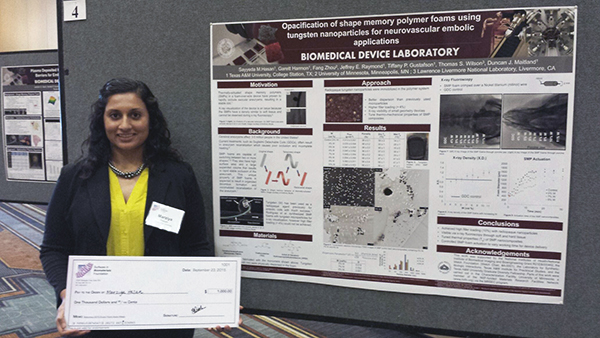
Sayyeda Marziya Hasan, graduate student in the Department of Biomedical Engineering at Texas A&M University, has earned top honors at the 2015 BioInterface Workshop and Symposium for her research poster detailing the development of radiopaque shape memory polymer (SMP) nanocomposites for use in neurovascular embolic devices.
Hasan, who works in the Biomedical Device Laboratory of Professor Duncan J. Maitland, is joined by fellow Texas A&M graduate students Anthony Boyle and Landon Nash who were named runners-up in the competition, giving Texas A&M – and Maitland’s laboratory – a clean sweep of the awards at this year’s conference.
Headed by Maitland, the Biomedical Device Laboratory develops a number of interventional devices including those based on SMPs. Research and development efforts include device fabrication, characterization, computational modeling, biocompatibility and functional in vivo studies.
At the symposium, Hasan, whose research focuses on fabrication and characterization of thermoset SMP foams, received top honors for her poster titled “Opacification of Shape Memory Polymer Foams Using Tungsten Nanoparticles for Neurovascular Embolic Applications.”
Boyle, a runner-up in the competition, has worked on the design, development and translation to commercialization of a novel SMP foam device for the treatment of intracranial saccular aneurysms. His poster detailed the development of the device.
Nash, also a runner-up, researches biomaterial surface modification using cold gas plasma. He was recognized for his poster about using a surface modification technique to increase the delivery time and clinical feasibility of catheter-based devices used to treat brain aneurysms.
The BioInterface Workshop and Symposium has been presented annually since 1991 by the Surfaces in Biomaterials Foundation and brings together engineers, scientists, clinicians and regulatory experts from all aspects of the biomedical community to openly discuss and debate recent innovations and research topics.
The Surfaces in Biomaterials Foundation is dedicated to exploring creative solutions to technical challenges at the biointerface by fostering education and multidisciplinary cooperation among industrial, academic, clinical and regulatory communities.
About the Department of Biomedical Engineering
Committed to solving the world’s greatest health problems through the exploration of new ideas, integrated research and innovation, the Department of Biomedical Engineering at Texas A&M is producing the next generation of biomedical engineers, developing new technologies and new jobs, and achieving revolutionary advancements for the future of health care. The department has unique strengths in regenerative engineering, medical augmentation, molecular diagnostics/theranostics, tele-health, and precision medicine, and its faculty members are internationally recognized with collaborative relationships that span engineering, physical and natural sciences, medicine and veterinary sciences.